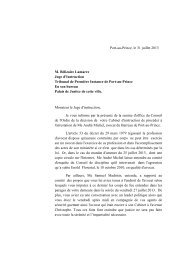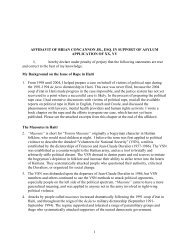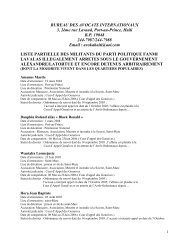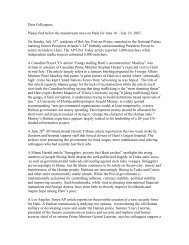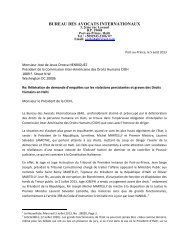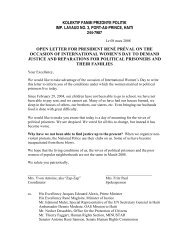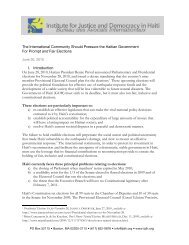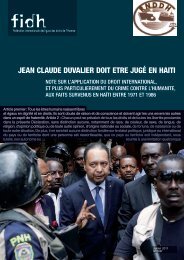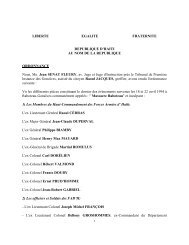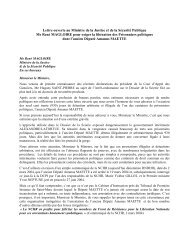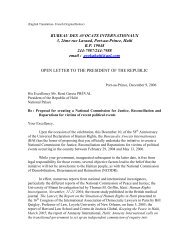Peacekeeping without Accountability - Yale Law School
Peacekeeping without Accountability - Yale Law School
Peacekeeping without Accountability - Yale Law School
- No tags were found...
Create successful ePaper yourself
Turn your PDF publications into a flip-book with our unique Google optimized e-Paper software.
Executive SummaryThis report addresses the responsibility of the United Nations (U.N.) for the choleraepidemic in Haiti—one of the largest cholera epidemics in modern history. The reportprovides a comprehensive analysis of the evidence that the U.N. brought cholerato Haiti, relevant international legal and humanitarian standards necessary tounderstand U.N. accountability, and steps that the U.N. and other key national andinternational actors must take to rectify this harm. Despite overwhelming evidencelinking the U.N. Mission for the Stabilization in Haiti (MINUSTAH) 1 to the outbreak, theU.N. has denied responsibility for causing the epidemic. The organization has refusedto adjudicate legal claims from cholera victims or to otherwise remedy the harmsthey have suffered. By causing the epidemic and then refusing to provide redress tothose affected, the U.N. has breached its commitments to the Government of Haiti, itsobligations under international law, and principles of humanitarian relief. Now, nearlyfour years after the epidemic began, the U.N. is leading efforts to eliminate cholera buthas still not taken responsibility for its own actions. As new infections continue tomount, accountability for the U.N.’s failures in Haiti is as important as ever.The Cholera Epidemic in Haiti and U.N.<strong>Accountability</strong>: BackgroundIn October 2010, only months after the countrywas devastated by a massive earthquake, Haiti wasafflicted with another human tragedy: the outbreakof a cholera epidemic, now the largest in the world,which has killed over 8,000 people, sickened morethan 600,000, and promises new infections for adecade or more. Tragically, the cholera outbreak—the first in modern Haitian history—was causedby United Nations peacekeeping troops whoinadvertently carried the disease from Nepal tothe Haitian town of Méyè. In October 2010, theU.N. deployed peacekeeping troops from Nepal tojoin MINUSTAH in Haiti. The U.N. stationed thesetroops at an outpost near Méyè, approximately 40kilometers northeast of Haiti’s capital, Port-au-Prince. The Méyè base was just a few meters froma tributary of the Artibonite River, the largestriver in Haiti and one the country’s main sourcesof water for drinking, cooking, and bathing.Peacekeepers from Nepal, where cholera is endemic,arrived in Haiti shortly after a major outbreakof the disease occurred in their home country.Sanitation infrastructure at their base in Méyèwas haphazardly constructed, and as a result,sewage from the base contaminated the nearbytributary. Less than a month after the arrival ofthe U.N. troops from Nepal, the Haitian Ministry ofPublic Health reported the first cases of cholera justdownstream from the MINUSTAH camp.Cholera spread as Haitians drank contaminatedwater and ate contaminated food; the country’salready weak and over-burdened sanitary systemonly exacerbated transmission of the diseaseamong Haitians. In less than two weeks after theinitial cases were reported, cholera had alreadyspread throughout central Haiti. During the first30 days of the epidemic, nearly 2,000 people died.By early November 2010, health officials recordedover 7,000 cases of infection. By July 2011, cholerawas infecting one new person per minute, and thetotal number of Haitians infected with cholerasurpassed the combined infected population ofthe rest of the world. The epidemic continued toravage the country throughout 2012, worsenedby Hurricane Sandy’s heavy rains and flooding1 executive summary



